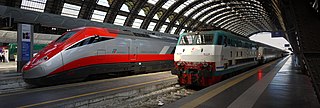
The Italian railway system is one of the most important parts of the infrastructure of Italy, with a total length of 24,227 km (15,054 mi) of which active lines are 16,723 km. The network has recently grown with the construction of the new high-speed rail network. Italy is a member of the International Union of Railways (UIC). The UIC Country Code for Italy is 83.
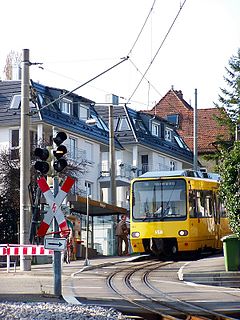
The Stuttgart Rack Railway is an electric rack railway in Stuttgart, Germany. It is the only urban rack railway in Germany, and one of only four rack railways operating in Germany, along with the Bavarian Zugspitze Railway, the Drachenfels Railway and the Wendelstein Railway.

Rigi Railways is a railway company that operates a group of railways on the mountain Rigi, located between two of the arms of Lake Lucerne, in Switzerland. They include two standard gauge rack railways, the Vitznau–Rigi Bahn (VRB) and the Arth–Rigi Bahn (ARB), along with the Luftseilbahn Weggis–Rigi Kaltbad (LWRK) cable car.

The Gornergrat Railway is a mountain rack railway, located in the Swiss canton of Valais. It links the resort village of Zermatt, situated at 1,604 m (5,262 ft) above mean sea level, to the summit of the Gornergrat. The Gornergrat railway station is situated at an altitude of 3,089 m (10,135 ft), which makes the Gornergrat Railway the second highest railway in Europe after the Jungfrau, and the highest open-air railway of the continent. The line opened in 1898, and was the first electric rack railway to be built in Switzerland.
Monte Santomarco is a railway tunnel in the Calabria region of Italy. The electrified line is 15,333 m long and was opened in 1987 replacing a standard-gauge rack railway line. It is a single track tunnel on the Paola-Cosenza line with a passing loop in the middle, about 800 metres long.

The Shinetsu Main Line is a railway line, consisting of three geographically separated sections, operated by the East Japan Railway Company in Japan. It was originally one continuous line connecting Takasaki and Niigata via Nagano. Since the opening and later extension of the Hokuriku Shinkansen, sections running in parallel have either been abandoned or transferred to third-sector railway companies.

The Hay railway line is a partly closed railway line in New South Wales, Australia. The line branches from the Main South line at Junee, and passes in a westwards direction through the towns of Coolamon and Narrandera to Yanco. The first train arrived in Hay on 4 July 1882. The line beyond Yanco to Hay is now closed, although the section to Willbriggie remained open for grain haulage until 2004. At Yanco, the still-open Yanco to Griffith line branches off in a northwesterly direction to Griffith.
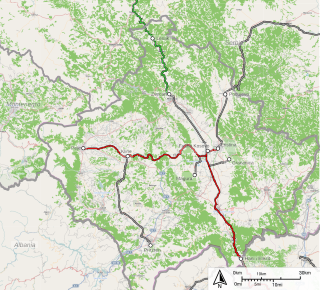
Kosovo Railways, is the national railway company of Kosovo. It was originally formed as the Kosovo Railways J.S.C UNMIK Railways from the lines of the former Yugoslav Railways that lie on Kosovar territory. In 2011, the company was split into two public companies called Trainkos and Infrakos, the latter responsible for rail maintenance.

The Verona–Bologna railway is a major Italian railway connecting Verona and Bologna and part of the major axis from the Brenner railway to the Bologna–Florence and on to Rome. The line is part of the Line 1 of Trans-European Transport Networks (TEN-T). It is considered a "fundamental" line by the state railways Ferrovie dello Stato (FS).

L'Aquila railway station serves the city and comune of L'Aquila, in the region of Abruzzo, southern Italy. Opened in 1875, it forms part of the Terni–Sulmona railway.

Meiringen railway station is a railway station, in the town of Meiringen in the Swiss canton of Bern, and at the junction of two railway lines. The Brünig line of the Zentralbahn is an inter-regional metre gauge railway that links Interlaken and Lucerne, whilst the Meiringen–Innertkirchen line of the Meiringen-Innertkirchen-Bahn (MIB) is a local railway that links to Innertkirchen and the Aare Gorge.

The Bologna–Ancona railway is an Italian railway that connects the city of Bologna with the city of Ancona, passing through the Po Valley to Rimini and along the Adriatic coast for the rest of the line.

Naples Metropolitan Railway service are two independent companies that operate a commuter rail system in Naples. The first one, Trenitalia, operates line 2 from Pozzuoli Solfatara to Gianturco station in East of Naples. The other one, EAV, operates the Circumvesuviana, Cumana, Circumflegrea and MetroCampania NordEst. In Italy, Naples is the only city possessing two independent metropolitan railway service companies.

The Terni–Sulmona railway is a regional railway line in central Italy, managed by Rete Ferroviaria Italiana. It links three regions, Umbria, Lazio and Abruzzo, and three provincial capitals: Terni, Rieti and L'Aquila. Together with the Sulmona–Isernia railway it forms a north–south corridor through the Apennines in central Italy. Its route is the result of two unfinished railways that had to meet in Rieti: the Pescara–L'Aquila–Rome line, and the Terni–Avezzano–Roccasecca line.
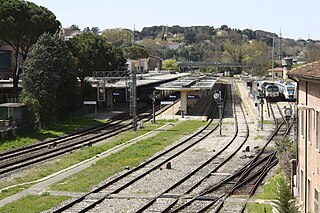
The Empoli–Siena–Chiusi railway is an Italian railway that connects Empoli and Siena to the Florence–Rome railway at Chiusi. The route between Empoli and Siena follows the valleys of Elsa river as far as Poggibonsi and then the Staggia stream, which were very convenient when the line was planned. The route is in fact flat and substantially straight from Empoli to Poggibonsi, then ascends with wide and long curves through the hills of central Tuscany to Siena.

The Altstätten–Gais railway is a metre-gauge in Switzerland. The 7.65 kilometre-long line was opened in 1911 by the Altstätten-Gais-Bahn (AG) and has been operated by the Appenzell Railways. Three sections of the line are equipped with rack under the strub system.
The Naples–Foggia railway is an Italian railway line connecting Naples, in Campania, with Foggia, in Apulia, crossing the Apennines at the saddle of Ariano through a series of tunnels.
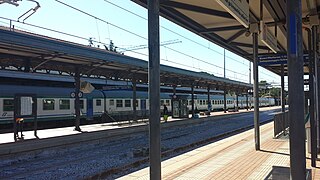
Cecina railway station is an Italian railway station on the Tirrenica railway line in Tuscany.

Sicily had at one time an extensive narrow gauge railway network. The design work was begun under at the time of the provisional management of the Southern Railways, continued by the Rete Sicula and built by Ferrovie dello Stato, which spread over the territory of five provinces: Palermo, Trapani, Agrigento, Caltanissetta, Enna; today the FS narrow-gauge network is completely abandoned and only the Circumetnea railway survives.
























